![]()
![]()
![]()
Use LEFT and RIGHT arrow keys to navigate between flashcards;
Use UP and DOWN arrow keys to flip the card;
H to show hint;
A reads text to speech;
36 Cards in this Set
- Front
- Back
- 3rd side (hint)
|
Alternation of Generations
|
The alternation of generations is a process that occurs in plants, protists, and fungi, in which the organisms cycle through generations that reproduce either sexually or asexually to perpetuate the species. A complete circuit makes up a complete lifecycle for the organism, whether it's a fern or an alga. Multiple generations occur during a single lifecycle, in contrast with most animals.
|
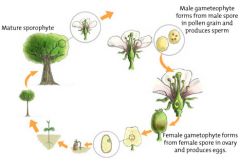
|
|
|
Double Fertilization
|
The process in which the two sperm nuclei of a pollen grain unite with nuclei of the embryo sac of an angiosperm plant. One sperm nucleus unites with the egg to form the diploid zygote, from which the embryo develops. The other sperm unites with the two nuclei located in a single cell at the center of the embryo sac. Together these nuclei form the triploid nucleus of the cell from which the endosperm develops. Double fertilization in this form is unique to the angiosperms.
|
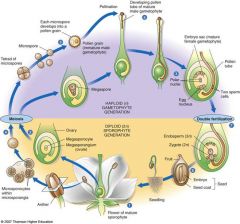
|
|
|
Trichromes
|
Trichromes are glandular hairs which are found on many different plants.
Trichromes serve two main purposes: 1) They are sticky and aid in catching male pollen. More trichromes = better chance of pollination. 2) THC absorbs UV-B light very well, acting as a veggie sunscreen. THC is produced in the trichromes. |
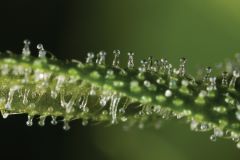
|
|
|
Secondary metabolite
|
Secondary metabolites are organic compounds that are not directly involved in the normal growth, development, or reproduction of an organism. Unlike primary metabolites, absence of secondary metabolites does not result in immediate death, but rather in long-term impairment of the organism's survivability, fecundity, or aesthetics, or perhaps in no significant change at all. Secondary metabolites are often restricted to a narrow set of species within a phylogenetic group. Secondary metabolites often play an important role in plant defense against herbivory and other interspecies defenses. Humans use secondary metabolites as medicines, flavorings, and recreational drugs.
|
|
|
|
macronutrients
|
Macronutrients consist of nine essential elements. Six of these that contribute to production of organic compounds required for formation of plant structure are carbon, oxygen, hydrogen, nitrogen, phosphorous and sulfur. The remaining three macronutrients are potassium, calcium, and magnesium.
|
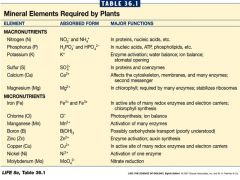
|
|
|
micronutrients
|
Micronutrients generally function as cofactors and a non-protein helper in the catalysis of an enzymatic reaction. Thus, micronutrient deficiency may weaken or kill a plant.
|
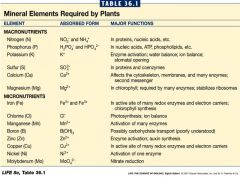
|
|
|
Hydroponics
|
ydroponics is the practice of growing plants without soil. Most commonly, hydroponics cultivates plants in nutrient-rich water, although hydroponics can also be considered to be the practice of growing plants in other aggregates, such as a soil-less bark-based mix. Hydroponics is an advantageous method of gardening both for home and commercial use. There are no weeds to deal with, and hydroponic plants are typically more healthy, mature earlier, and use less space.
|
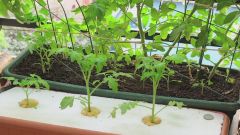
|
|
|
Symbiotic
|
These are plants that have a mutually beneficial relationship with each other, without any negative benefits to either partner - as opposed to a parasitic relationship.
An example would be Bryophytes, which have aerial root systems. They attach themsleves to the barks of trees for anchorage as well as to gain height in the tree canopy. The roots do not penerate the bark or damage the host plant. |
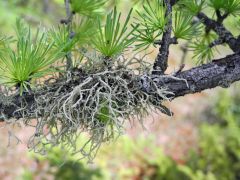
|
|
|
mutualistic
|
A mutualistic relationship is when two organisms of different species "work together," each benefiting from the relationship.
Organisms in a mutualistic relationship evolved together. Each was part of the other's environment, so as they adapted to their environment, they "made use of" each other in a way that benefited both. |
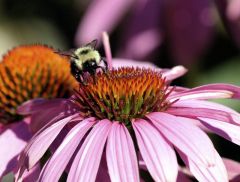
|
|
|
Mycorrhizae
|
The word mycorrhizae refers to a group of fungi which form a mutually beneficial relationship with many plants. These fungi grow either inside of a plant’s roots or attach to the surface of a root. The fungi benefits from the plant’s food and nutrients and in turn send their hyphae (like small roots) out into the surrounding soil to absorb nutrients and water.
So, mycorrhizae actually enhance a plant’s ability to take up nutrients and water. Because of this, research has shown that the presence of mycorrhizae also help plants deal with drought and some diseases. |

|
|
|
Nitrogen fixation
|
Nitrogen Fixation, a process of combining atmospheric nitrogen with other elements to form useful compounds. There are only a few ways in which nitrogen, which is relatively inert, can be combined with other elements. Nitrogen is essential to living things and, because most organisms cannot use nitrogen that is not combined with other elements, nitrogen fixation is important to the continuation of life on earth. Fixed, or combined, nitrogen is also necessary for the manufacture of many substances, including explosives and commercial fertilizers.
In nature, nitrogen is fixed by some micro-organisms and by lightning. This natural fixation plays an important role in the nitrogen cycle. In the 20th century, humans learned to fix nitrogen in large quantities to supplement the amount of nitrogen fixed naturally. Synthetic processes of nitrogen fixation include the electric arc process, the cyanamide process, and the Haber process. |
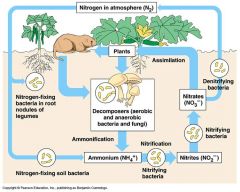
|
|
|
Xerophytes
|
A type of plant that is well-adapted to water shortages and exhibits adaptations that enable it to store or conserve water. Xerophytes often live in regions where evapotranspiration (the sum of evaporation and plant transpiration) is greater than precipitation for the region during all or part of the growing season. Adaptations that xerophytes might exhibit include succulent leaves and stems (to store water), fewer stomata (to reduce water loss), and a deep or widespread root system (to optimize water uptake).
|
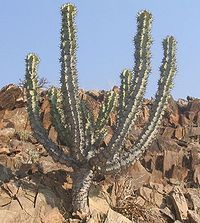
|
|
|
Stomatal Crypt
|
keeps water from leaving when it's hot. gas exchange.
|
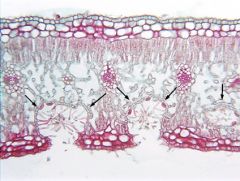
|
|
|
Pneumatophores
|
a specialized root of certain swamp plants, such as the mangrove, that branches upwards, rising above ground, and undergoes gaseous exchange with the atmosphere
|
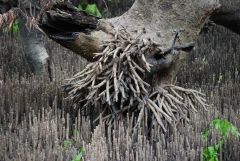
|
|
|
Lenticel
|
any of numerous pores in the stem of a woody plant allowing exchange of gases between the plant and the exterior
|
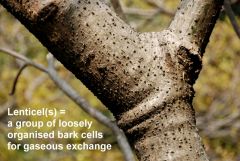
|
|
|
Stolon
|
a long horizontal stem, as of the currants, that grows along the surface of the soil and propagates by producing roots and shoots at the nodes or tip
|
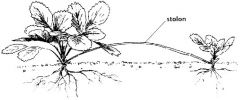
|
|
|
Rhizomes
|
A plant stem that grows horizontally under or along the ground and often sends out roots and shoots. New plants develop from the shoots. Ginger, iris, and violets have rhizomes.
|
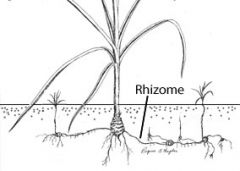
|
|
|
Plasmodesmata
|
Plasmodesmata (singular, plasmodesma) are small channels that directly connect the cytoplasm of neighboring plant cells to each other, establishing living bridges between cells. Similar to the gap junctions found in animal cells, the plasmodesmata, which penetrate both the primary and secondary cell walls (see Figure 1), allow certain molecules to pass directly from one cell to another and are important in cellular communication.
|
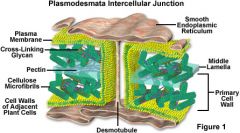
|
|
|
Symplast
|
The symplast of a plant is the inner side of the plasma membrane which is continuous with the cytoplasm. It is responsible for the majority of transport changes during a plant's life. Within the symplast, water and solutes diffuse freely (Figure 1). Small molecules including sugars, amino acids and ions flow directly between cells via the symplastic pathway. Additionally, larger molecules such as transcription factors and viruses can traverse the symplast when their transport is facilitated by actin structures.
Symplastic transport allows the flow of water and nutrients between plant cells. Symplastic transport also plays a critical role in root systems by bringing nutrients from the soil. Through symplastic transport, these soil nutrients travel from the plant epidermis through the cortex into the endodermis, and ultimately into the pericycle where the nutrients make their way into xylem for long distance transport. Symplastic transport differs from apoplastic transport in that it does not involve movement from cell wall to cell wall. |
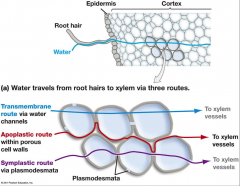
|
|
|
Apoplast
|
The apoplast is the "non-living" extracellular space that surrounds the symplast. It consists of cell walls and spaces between cells. Water and solutes can move freely in this framework, except at the endodermis in roots and stems where the apoplastic flow of ions is interrupted by the Casparian strip, forcing water to flow to symplast.
|

|
|
|
Passive Exclusion
|
1. Casparian Strip =
‘Selective’ filter in endodermis . Variation in number of membrane channels e.g. sodium |

|
|
|
Active Exclusion
|
1. Metallothioneins
2. Vacuoles sequester excess |
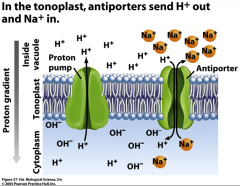
|
|
|
Casparian strip
|
Waxy, water-repelling belt (hydrophobic) around each endodermal cell
Prevents water and ions from moving between cells Must cross plasma membranes in other locations to get in |
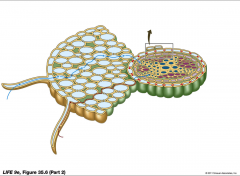
|
|
|
Proton pump
|
ATP used to drive H+ from inside cell to out
The differential electrical charge drives K+ into cell Anions such as Cl – can enter cell as H+ diffused back in |

|
|
|
Plant Tissues: Apical Meristem
|
A group of undifferentiated plant cells, at the tip of a stem or root, that is responsible for primary growth
|
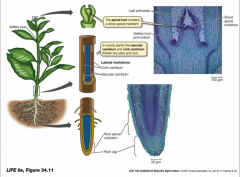
|
|
|
Plant Tissues: Lateral Meristem
|
A layer of undifferentiated plant cells found in older stems and roots that is responsible for secondary growth.
|

|
|
|
Plant Tissues: Dermal
|
Protection:
-cuticle - waxy, hydrophobic, prevents water loss (lipstick, polish, carnauba wax) -Trichromes - hair-like, reflect light, store toxins, sting, decrease evaporation (protect from UV and herbivores - Regulate Gas Exchange - stomata and guard cells |
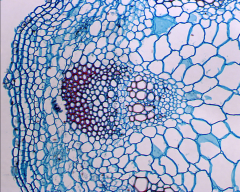
|
|
|
Plant Tissue: Ground
|
Makes up bulk of the plant
Includes parenchyma (also found in dermal and meristematic) and possibly sclerenchyma and collenchyma FUNCTIONS: photosynthesis storage of nutrients, hormones, pigments, toxins support |

|
|
|
Plant Tissue: Vascular
|
Cell types include Xylem (Sclerenchyma) and Phloem (parenchyma)
Will go into detail and review these vessel a couple of slides from now |
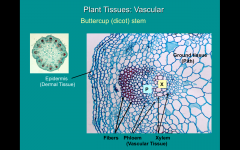
|
|
|
Vascular Phloem
|
PHLOEM:
Living parenchyma cells sieve tube members: lack most organelles and nuclei companion cells: have orgenelles, maintain sieve tube cells ** these are connected by PLASMODESMATA FUNCTION: Transport sugars, aa, hormones – like subway stops – upload or disperse carbs, nutrients Companion cells Sieve plates Phloem -> parenchyma |

|
|
|
Vascular Xylem
|
XYLEM
Cells dead at maturity have secondary cell walls – tracheids or vessels |
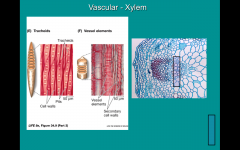
|
|
|
Meristematic
|
MERISTEMATIC
stem-cell like divide rapidly undifferentiated |
|
|
|
Parenchyma
|
Living
Totipotent – can form new shoots and rots from cuttings FUNCTIONS photosynthesis – contain chloroplasts store nutrients – e.g. starch nutrient transport - phloem |
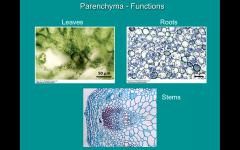
|
|
|
Collenchyma
|
A structural tissue like sclerenchyma and…
Living Often appear as peripheral cylinders underlying epidermis (or separated by some parenchyma) Prismatic in appearance sometimes long, thin, flexible regions in the plant, or permanent parts of structures like leaf petioles primary cell wall has thickened corners; no secondary wall! Uses cellulose and pectin – not lignified FUNCTIONS structural support for actively growing regions e.g. leaf petioles, woody stems, growing organs |
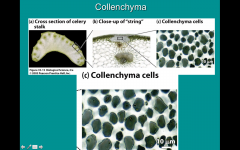
|
|
|
Sclerenchyma
|
Dead at maturity
tough, rigid supportive tissue (2nd wall with lignin) FUNCTIONS support mature stems and other plant parts transport water, minerals e.g. tracheids, vessels, fibers (hemp, jute, paper), sclerids (protection, nut coats) |

|
|
|
Dicot & Monocot Roots
|
Note that the arrangement in
monocot roots looks similar to dicot stems. |
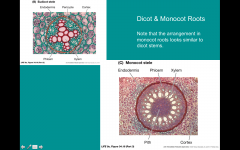
|

